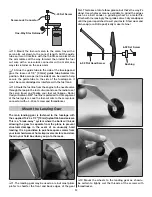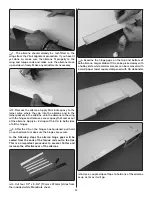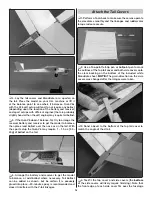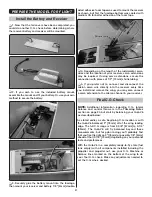
34
2) I will not fl y my model aircraft higher than approximately
400 feet within 3 miles of an airport without notifying the
airport operator. I will give right-of-way and avoid fl ying
in the proximity of full-scale aircraft. Where necessary,
an observer shall be utilized to supervise fl ying to avoid
having models fl y in the proximity of full-scale aircraft.
3) Where established, I will abide by the safety rules for the
fl ying site I use, and I will not willfully and deliberately fl y my
models in a careless, reckless and/or dangerous manner.
5) I will not fl y my model unless it is identifi ed with my name
and address or AMA number, on or in the model.
NOTE:
This does not apply to models while being fl own indoors.
7) I will not operate models with pyrotechnics (any device
that explodes, burns, or propels a projectile of any kind).
Radio Control
1) I will have completed a successful radio equipment ground
check before the fi rst fl ight of a new or repaired model.
2) I will not fl y my model aircraft in the presence of
spectators until I become a qualifi ed fl ier, unless assisted
by an experienced helper.
3) At all fl ying sites a straight or curved line(s) must be
established in front of which all fl ying takes place with the
other side for spectators. Only personnel involved with
fl ying the aircraft are allowed at or in the front of the fl ight
line. Intentional fl ying behind the fl ight line is prohibited.
4) I will operate my model using only radio control frequencies
currently allowed by the Federal Communications Commission.
5)
I will not knowingly operate my model within three
miles of any pre-existing fl ying site except in accordance
with the frequency sharing agreement listed
[in the
complete AMA Safety Code].
9) Under no circumstances may a pilot or other person
touch a powered model in fl ight;
nor should any part
of the model other than the landing gear, intentionally
touch the ground, except while landing.
QUIK-V6 TRIMMING NOTES
By Jim Allen
Quickie 500 racing has seen its share of development
since its inception in the early 70’s, but the premise has
remained the same; to develop the skills necessary for
AMA 3-pole racing with simple, .40-size planes that fl y
well. The Quik-V6 is an example of the latest design in the
series with a shoulder-wing and V-tail that originated with
the original Quik-V in 1987.
Racing your Quik-V6 is fun, but it can be even better with
a plane that is properly setup and trimmed making it as
easy as possible to get around the course quickly and
consistently—it all comes down to doing the
little things
that improve your lap times. The easier it is to fl y those
fast lap times consistently, the better your heat times
will be. This guide will walk you through the process of
trimming your Quik-V6 to allow you to make the most of
its great fl ying qualities.
C.G.:
If you haven’t yet done so, accurately set the initial C.G.
according to the specifi cations in this manual. Eventually,
you may end up fi ne tuning the C.G. to adjust the way the
plane fl ies on the course, but you need a good starting point
and we’ll cover adjusting the C.G. with fl ight trimming later.
LATERAL BALANCE:
Now check the lateral balance also
as described in this manual. Taping coins to the bottom of
the wing works well, or you can use lead tape available at
golf stores or on e-bay. Same as the C.G., lateral balance
may also end up changing based on the way the plane fl ies.
THROWS:
Over-controlling or over-fl ying a pylon racer
results in lower lap times and consequently lower heat
times. Every time you move a control surface you increase
drag slowing the plane. The more you move the surfaces
the more the plane slows. Minimizing control movement
while maintaining a tight course will always result in faster
lap times. Learning to fl y those faster laps consistently will
result in faster heat times and more heat wins. Set your
throws as recommended in this manual. This will be a
good place to start. Low rates are intended for racing and
high rates are fi ne for sport fl ying or for landing in windy
or bumpy conditions. When measuring throws, use a ruler
with fi ne increments such as a machinist’s 6-inch rule.
AILERON DIFFERENTIAL:
Note that the rotation pin on
the included swivel clevises on the aileron torque rods
should provide close to equal up and down throw for the
ailerons. This is important – you do not want more than
a 1/32" [.8mm] difference in up vs. down. If there is a
difference, more up throw than down throw is preferred. If
necessary, the degree of up or down aileron throw can be
altered by changing where the aileron pushrods connect
to the aileron servo wheel—moving the pushrod holes
in the servo wheel forward (toward the leading edge of
the wing) will provide more up throw; the opposite will
increase down throw. If you have to resort to this, a blank
servo wheel will be required so you can drill your own
offset holes. Try to work to make sure both ailerons are
the same—the Quik-V6 does not require differential.
ELEVATOR SYNCHRONIZATION:
For the Ruddervators,
make sure the
elevator
movement is the same on both
sides. Remember, the elevator is relying on separate
servos and separate linkages potentially contributing to
small differences in throw. If necessary, use the End Point
adjustment in your radio to equalize elevator throw. Later,
after fl ying, we may come back to this while trimming for
the course, but begin by getting the throws as close as
you can on the bench. Again, measure carefully with a
fi ne-increment ruler.
FLIGHT TRIMMING:
The plane is now ready to fl y. The
fi rst order of business is always to get the plane trimmed
for straight-and-level fl ight. Make extended passes at
that are not too close and not too high so you can really
get a good read on how it’s trimmed. As the trimming
process continues, always re-trim for level fl ight before
you do anything else. And don’t even think about putting
your Quik-V6 down on the course until you’ve trimmed it!
This is important.
TURN RADIUS:
Whether racing around a 2-pole course
(standing outside the course) or around the 3-pole course
(standing within the course near pylons 2 and 3), your turns



































